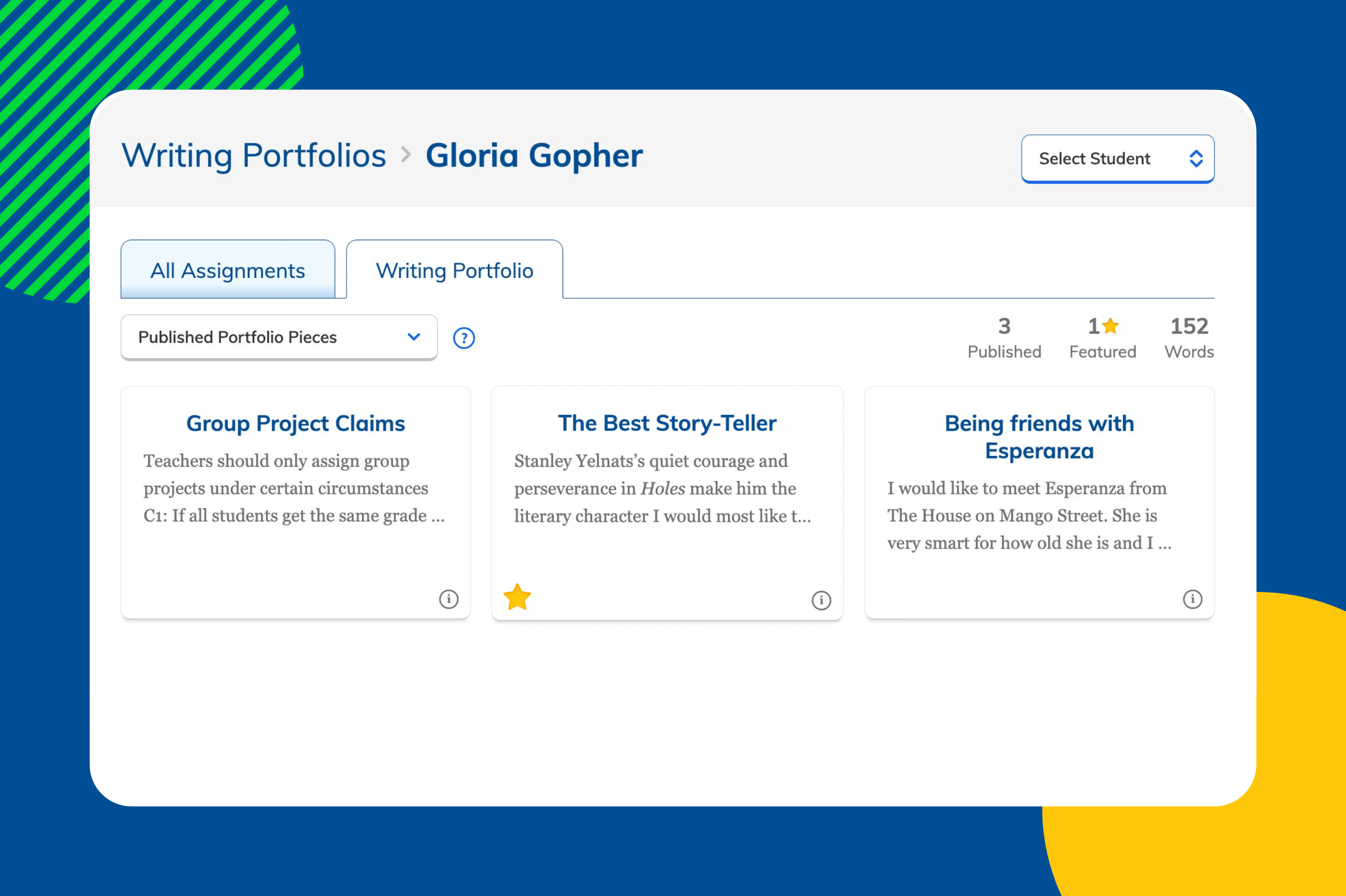New in NoRedInk: Writing Portfolios

NoRedInk’s new feature, Writing Portfolios, makes it easy to preserve, track, and celebrate student writing.
Each day, students complete thousands of writing assignments on NoRedInk. Our student writing activities create a variety of opportunities for learners to apply their skills and develop writing fluency and stamina. To make these activities even more valuable for students and teachers, NoRedInk has rolled out an exciting new feature: student Writing Portfolios.
What is a Writing Portfolio?
NoRedInk Writing Portfolios give educators access to lasting, personalizable collections of student writing samples. Each student account now includes an online writing portfolio that follows the student for as long as they use NoRedInk.
Writing Portfolios are automatically populated by every Quick Write and Guided Draft students submit, provided the assignments have due dates of July 1, 2022, or later. Students are able to curate their portfolios of writing samples by adding work from prior to July 1, removing work, or featuring work they’re particularly proud of. Featured pieces are pinned to the top of a student’s Writing Portfolio so that the student and their teachers have easy access to these standout samples.
Teachers are able to review the Writing Portfolios of every student currently enrolled in their classes. They can see final drafts of all the student writing samples included in these portfolios, as well as rough drafts, scores, and comments for any pieces of work they originally assigned. Teachers have two ways to navigate to student Writing Portfolios:
- Click on the new “Writing Portfolios” tab on their Student Data page.
- Click on a student’s name in the “Grades” tab on their Student Data page, then click on the new “Writing Portfolio” tab in the student-level view.
Why are student Writing Portfolios important?
Because they contain work from previous years, Writing Portfolios give teachers instant insight into the strengths and opportunities for improvement that exist across their classes at the start of a new school year. This visibility into past work helps teachers get to know their students quickly and set personalized student writing goals.
As the year progresses, Writing Portfolios offer an easy way for teachers to zero in on the writing they should dedicate the most time to reviewing. This streamlines both weekly grading routines and the process of preparing for student writing conferences, IEP meetings, and/or parent-teacher conferences. It also enables teachers and schools to illustrate long-term growth by comparing student writing samples across multiple years.
By giving them the chance to curate their work, Writing Portfolios help students feel invested in their own growth as writers. They also provide convenient jumping-off points for self-reflection, especially when paired with metacognitive Quick Write prompts such as:
- “Post-work Reflection”: Write a paragraph reflecting on [last night’s homework/the essay you just turned in/last week’s test/etc.]. What parts of the task did you feel confident completing? What did you find challenging? What questions do you have?
- “Getting Unstuck”: Think about a time when you were completing a writing assignment and felt stuck. Write a paragraph explaining how you felt and what you did to get unstuck. Would you do anything differently next time?
- “Words of Encouragement”: Imagine that a younger student is trying to get better at [argumentative writing/narrative writing/analyzing complex texts/etc.] and is feeling frustrated and stressed. Write a short, encouraging letter to help this student. Your letter should include advice for staying motivated when the work is hard and 1-2 specific strategies the student can use to improve at this skill.
Empower students and track growth with NoRedInk’s online Writing Portfolios
At NoRedInk, we’re deeply invested in helping each and every student unlock the power of the written word. Writing Portfolios represent an important step in this effort, giving students a sense of ownership over their writing and teachers better visibility into student writing growth. Ultimately, Writing Portfolios make it easier for stakeholders across education to preserve, track, and celebrate student writing.
Sign up for free today to start developing stronger writers in your classroom!
